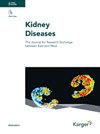Targeting Ferroptosis Attenuates Interstitial Inflammation and Kidney Fibrosis
IF 3.2
4区 医学
Q1 UROLOGY & NEPHROLOGY
引用次数: 33
Abstract
Background: Ferroptosis, an iron-dependent form of regulated necrosis mediated by lipid peroxidation, predominantly polyunsaturated fatty acids, is involved in postischemic and toxic kidney injury. However, the role and mechanisms for tubular epithelial cell (TEC) ferroptosis in kidney fibrosis remain largely unknown. Objectives: The aim of the study was to decipher the role and mechanisms for TEC ferroptosis in kidney fibrosis. Methods: Mouse models with unilateral ureter obstruction (UUO) or ischemia/reperfusion injury (IRI) were generated. Results: We found that TEC ferroptosis exhibited as reduced glutathione peroxidase 4 (GPX4) expression and increased 4-hydroxynonenal abundance was appeared in kidneys from chronic kidney disease (CKD) patients and mouse models with UUO or IRI. Inhibition of ferroptosis could largely mitigate kidney injury, interstitial fibrosis, and inflammatory cell accumulation in mice after UUO or IRI. Additionally, treatment of TECs with (1S,3R)-RSL-3, an inhibitor of GPX4, could enhance cell ferroptosis and recruit macrophages. Furthermore, inhibiting TEC ferroptosis reduced monocyte chemotactic protein 1 (MCP-1) secretion and macrophage chemotaxis. Conclusions: This study uncovers that TEC ferroptosis may promote interstitial fibrosis and inflammation, and targeting ferroptosis may shine a light on protecting against kidney fibrosis in patients with CKDs.靶向铁下垂减轻间质炎症和肾纤维化
背景:铁坏死是一种由脂质过氧化(主要是多不饱和脂肪酸)介导的铁依赖性调节坏死,与缺血后和中毒性肾损伤有关。然而,肾小管上皮细胞(TEC)铁下垂在肾纤维化中的作用和机制在很大程度上仍然未知。目的:研究TEC铁下垂在肾纤维化中的作用和机制。方法:制作单侧输尿管梗阻(UUO)或缺血再灌注损伤(IRI)小鼠模型。结果:我们发现,慢性肾病(CKD)患者和UUO或IRI小鼠模型的肾脏中,TEC铁吊表现为谷胱甘肽过氧化物酶4 (GPX4)表达减少,4-羟基烯醛丰度增加。抑制铁下垂可以在很大程度上减轻小鼠UUO或IRI后的肾损伤、间质纤维化和炎症细胞积聚。此外,用GPX4抑制剂(1S,3R)-RSL-3治疗TECs可增强细胞铁下垂并招募巨噬细胞。此外,抑制TEC铁下垂可降低单核细胞趋化蛋白1 (MCP-1)的分泌和巨噬细胞趋化性。结论:本研究发现TEC铁下垂可促进间质纤维化和炎症,靶向铁下垂可能有助于预防ckd患者肾纤维化。
本文章由计算机程序翻译,如有差异,请以英文原文为准。
求助全文
约1分钟内获得全文
求助全文
来源期刊

Kidney Diseases
UROLOGY & NEPHROLOGY-
CiteScore
6.00
自引率
2.70%
发文量
33
审稿时长
27 weeks
期刊介绍:
''Kidney Diseases'' aims to provide a platform for Asian and Western research to further and support communication and exchange of knowledge. Review articles cover the most recent clinical and basic science relevant to the entire field of nephrological disorders, including glomerular diseases, acute and chronic kidney injury, tubulo-interstitial disease, hypertension and metabolism-related disorders, end-stage renal disease, and genetic kidney disease. Special articles are prepared by two authors, one from East and one from West, which compare genetics, epidemiology, diagnosis methods, and treatment options of a disease.
 求助内容:
求助内容: 应助结果提醒方式:
应助结果提醒方式:


